Archive for the ‘General’ Category
3 Benefits of Supplementing Horses with Magnesium
Editors note: This article has been sourced from Riva’s Remedies.
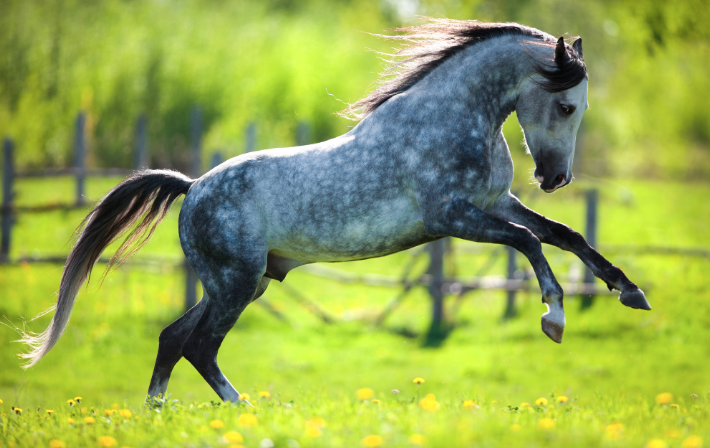
Magnesium is a very well-known mineral and is used by millions of people for its health benefits. Magnesium is required for the normal function of every cell in the body and is necessary for muscle and joint health, metabolism, energy levels, and a healthy nervous system. It is therefore an extraordinary mineral for horses since our horses need a lot of support for both their muscle function and their stress levels.
And, since grass and hay does not usually provide enough magnesium to meet their daily requirements horses often exhibit signs of deficiency such as irritability, muscle tension, muscle fatigue, spasms, nerve pain, and Insulin Resistance.
But even though magnesium deficiencies are common, your equine partner doesn’t need to be deficient to benefit from the numerous benefits of magnesium. Like all minerals, magnesium, when provided in therapeutic dosages, can help horses with a variety of different health conditions.
Let’s take a look at 3 of the most common uses of magnesium for horses:
1) Bone and muscle function
Sixty percent of tissue magnesium is located in the skeleton. It is essential for maintaining healthy bones by initiating the chemical pathway for calcium absorption. It helps to dissolve calcium in the blood for absorption into the tissues and bones. When magnesium levels are too low for a long time, it can lead to calcification of the bones and joints which can contribute to bone spurs, arthritis, and hoof pathologies.
While calcium is responsible for muscle contraction, magnesium is required for muscle relaxation. Deficiency signs include muscle spasms, cramping, fatigue and an irregular heartbeat. Magnesium can also be used therapeutically to alleviate muscle tightness, tension and spasms. As an anti-spasmodic, magnesium can also help relax the intestinal muscles during episodes of colic, both acute and chronic.
2) Conditions of the nervous system
Magnesium supports the nervous system by regulating neurotransmitters and facilitating nerve transmission. It is also heavily involved in managing the stress response by supporting healthy production of cortisol from the adrenal glands. Horses that are deficient in magnesium will often exhibit nervous behavior, anxiety, and a low threshold for stressful events. As a result, magnesium is commonly used as a natural relaxant for high strung or anxious horses during times of physical and emotional stress. It can even be used as a remedy for neurological conditions.
3) Sugar metabolism and energy production
Magnesium is also very important for carbohydrate or sugar metabolism. This can be especially beneficial for horses that are easy keepers or horses that are Insulin Resistant or have Cushing’s Syndrome (PPID). Magnesium plays a key role in converting glucose from feed to energy. If magnesium levels are depleted, the cells will be more resistant to insulin which is the hormone responsible for transporting glucose into the cells for energy.
Factors that can lead to magnesium deficiency in horses
- Insufficient levels in grass and hay
- Stress
- Diarrhea
- The use of diuretics
- Toxic heavy metals
Now that you know more about the signs of magnesium deficiency in horses, what type of magnesium should you use?
When choosing a magnesium supplement for your horse it is important to know which one is going to get the best results. There are many different types of supplements out there and no two are created the same.
Let’s explore your options…
Minerals are naturally derived from the earth and are essential to sustain every physiological function in the body – human and animal. All minerals, including magnesium, are classified as inorganic elements because of their chemical properties and position on the periodic table.
However, when supplementing magnesium as a dietary nutrient there are two types available for horses that you should be aware of: organic and inorganic.
Organic magnesium for horses
Organic magnesium is the most bioavailable form for horses.
Common organic forms of magnesium include:
- Magnesium citrate
- Magnesium gluconate
- Magnesium bisglycinate
These magnesium compounds are considered organic because the magnesium is chelated or attached to a carbon containing molecule. Bonds that contain carbon more closely resemble the natural compounds found in plants and other living things. This allows them to be more easily recognized by absorption sites and transported from the small intestine into the bloodstream.The rate of magnesium absorption depends on the group that is chelated to magnesium. Magnesium citrate has a reported absorption rate of approximately 30% which is higher than many inorganic forms.
Inorganic magnesium for horses
Inorganic magnesium is the most common form found in equine supplements and horse feed, but it is also the least bioavailable compared to organic forms.
The two most common types of inorganic magnesium are:
- Magnesium sulfate
- Magnesium oxide
Both of these magnesium compounds are classified as inorganic because they don’t contain carbon in their chemical structure. As a result, the body doesn’t recognize them as naturally occurring molecules such as those found in plants. Consequently, they aren’t broken down as easily into smaller units for transport across the intestinal lining into the bloodstream. Magnesium oxide, for example, has been reported to have an absorption rate as low as 4%.
It is also worth noting that dietary minerals compete for absorption. After inorganic molecules are broken down into positively or negatively charged ions, they are attracted to certain binding sites on the intestinal lining. Ions from other minerals with the same charge can often interfere and prevent other inorganic minerals ions from binding.
This is further evidence that your horse is possibly only absorbing a fraction of what they are getting in any commercial feed program. It also explains why many horses still show signs of nutrient deficiencies even though they are regularly supplemented with a mineral mix and a complete feed.
Organic forms of magnesium are always superior for horses…
It is estimated that up to 20% of all horses and over 50% of sick horses are deficient in magnesium! It is therefore important to select a high-quality organic form that is bioavailable and will deliver maximum benefit.
Unfortunately, when horse owners are looking for a magnesium supplement for their horses, they will often choose magnesium oxide because it is less expensive than the organic forms. The price difference is because the oxides don’t require the extra processing to chelate the magnesium with a carbon-containing group.
However, it is our that experience that not only do horses do better on the organic forms of magnesium, but most horse owners are always glad they chose a higher quality magnesium supplement to get the results their horse needs.
How much magnesium does your horse need?
Most horses respond well to 1,500 mg daily of magnesium citrate which is usually enough to correct most deficiencies and to provide relief from stress, tension, or muscle tightness.
However, when using magnesium to relieve acute pain, colic, or muscle spasms, a loading dose of 3,000 mg daily can be given for the first few days, or as needed for comfort. Once the horse responds, the dosage can be lowered to 1,500 mg daily.
In summary, if you suspect that your horse is deficient in magnesium or if you think that they might benefit from the many amazing properties of magnesium, make sure to supplement with an organic form to ensure high absorption.
And remember, you should never have to feed a supplement forever. A course of 4 – 6 weeks is plenty of time for your horse to demonstrate the benefits and then you can reduce to a maintenance dose as required or use as needed.
De-worming Your Horse: Using Chemicals and Herbs for Management and Prevention
Editor’s Note: This article has been sourced from Riva’s Remedies.
Why do Horses get Parasites?
Of all domestic livestock, horses have the largest numbers of parasites including large strongyles, small strongyles, roundworms, and pinworms. Roundworms only affect weanlings and yearlings, with encysted larvae migrating to the liver, heart, or lungs. Infected youngsters will generally show symptoms of malnutrition, colic, failure to thrive, unhealthy hair coat, pot belly, and possible coughing. Pinworms lay eggs around the anus of the horse, causing tail itching and hair loss. However, I find that most cases of tail itching in the summer time is actually due to the sugars in the grass.
Horses that graze on grass in a domesticated living environment are the most susceptible, since parasites spend a part of their life cycle living on the grass blades. In fact, studies have determined that grazing horses are far more likely to host parasites than those horses housed on dry lots with hay diets. Horses graze close to the ground and, more than other livestock, are always smelling, nibbling, and licking, whereby they can pick up large numbers of infective larvae.
Grazing horses are also at risk if they are allowed to overgraze their pasture, because overgrazed, nutrient-poor grass favours higher larval populations. Insufficient space for multiple horses is also a risk factor because in tight quarters they are more likely to pick up eggs shed by one another.
The Path of the Parasite?
Once in the horse’s digestive tract, female parasites lay eggs in the hindgut. In the spring, these eggs are passed to the ground inside the feces. Under proper environmental conditions, including warmth and moisture, the eggs hatch into larvae in the manure. But under cold and dry conditions, the eggs can survive un-hatched for long periods, waiting to emerge when the conditions are right. The infective larvae migrate onto grass blades, where they remain until grazing horses swallow them. They then develop into young parasites in the intestines.
Encysted Strongyles
Usually in the fall, prompted by the changes in daylight, ingested intestinal larvae penetrate the wall of the large intestine and begin another life cycle within the host. These hibernating larvae are called encysts.
Large strongyles, known as bloodworms, can enter the bloodstream as encysts and migrate for six to seven months along the walls of the arteries including the mesenteric artery, the liver, the kidneys, the pancreas, and the intestinal wall causing tissue damage and symptoms of organ dysfunction. They eventually return to the large intestine as young adults. Large strongyles can be responsible for weight loss, a dull coat, poor appetite, a pot belly, itching, fatigue, bloating, colic, diarrhea, and hoof toxicity.
But the most common parasites to infect equines are small strongyles. They are particularly problematic because they burrow into the intestinal lining of the large intestine where they can stay for years. In defence the horse’s body creates inflammation and forms scar tissue around each larvae. The process forms little blood-filled cysts which the larvae can feed off. Small strongyles can therefore cause colic, anemia, weight loss, and mal-absorption of nutrients.
Bear in mind that it is not of benefit for any type of parasite to kill off its host so most horses continue to get sicker rather than die.
Treatment
The treatment of equine parasites is not as simple as we think. Nor is it as easy as shooting a full syringe of any dewormer into your horse’s mouth twice per year. Not only are there different types of parasites but each horse has different levels of resistance – some horses with a high count have no symptoms whatsoever and other horses with hardly any infestation have no resistance at all and show a variety of symptoms. As well, there is much concern about over-medicating horses with chemical de-wormers leading to imbalances in the colon as well as the mutation and resistance of the parasites themselves. And unfortunately, for some horses, especially those with encysts or heavy loads, herbal and homeopathic treatments are not effective enough.
Chemical De-wormers – The Risks
Chemical de-wormers came on the scene in the 1960s to target all species of worms. Only one new de-worming medicine has been introduced in the past 15-20 years and few new ones are expected. In recent years, however, the chemical war on parasites has become less popular for the following reasons:
- Worms, especially small strongyles and roundworms, adaptive creatures that they are, have learned to build resistance. This has no doubt been spurred on by overly-aggressive parasite drug treatments putting selective pressure on worms to mutate. The indiscriminate and repetitive use of chemical de-wormers on horses (especially those horses who may not even be infested), leads to parasitic mutation, and puts the horses at risk for toxic chemical overload and compromised immunity.
- Using chemical dewormers too often (e.g. daily or weekly) or using excessive dosages can contribute to intestinal damage, a change in the colonic ecosystem, a depletion of probiotics, liver and kidney stress, and overall chemical toxicity. Adverse reactions to all chemical de-wormers may include drooling, colic, swellings, weight loss, allergic reactions, and laminitis. Don’t keep repeating or increasing dosages or trying different medications when they are not working. Random treatments used in a parasite laden environment without improving the nutrition will accomplish very little. It is not a relentless war of eradication.
- Be cautious of de-wormers that claim to kill encysted larvae, since in order to do so the drug must chemically alter the intestinal membrane to access the larvae. In sensitive horses this can lead to leaky gut, malnutrition, colic, and weight loss – sometimes extreme.
- Chemical de-wormers often trigger the unaffected encysted larvae to emerge and develop into adult worms as soon as the drug is gone from the horse’s system. These newly developed adult parasites begin to shed eggs immediately and, depending on the time of year, can begin developing into parasites almost immediately.
- Small strongyles that are encysted in the intestinal walls only respond to two different chemicals: moxidectin and fenbendazole. If you use other less effective dewormers on a horse with an extreme overload of small strongyle encysts a dangerous process called emergence (Larval Cyathostomosis) can happen. Encysts in the intestinal wall will emerge into the colon all at once in an attempt to replace the non-encysted ones that have been killed by the de-wormer. This onslaught can cause colic, weight loss, diarrhea, and swelling.
- Only 30% of the horses in any herd (usually those with the lowest resistance) are carrying the majority of the parasite load. This means that nearly 70% of our horses are subjected to excessive and unnecessary chemicals on a regular basis.
- Chemical parasite control measures shift our focus away from more natural parasite preventions such as controlling environmental contamination and keeping our horses intestinal health resistant to infections of all kinds, including parasites.
Chemical Dewormers – When to Use
- Chemical dewormers are very much still a necessity for horses with a heavy parasite load, those who have not been treated on a regular basis, those horses who are primarily out on grass, and those horses who have encysts, of which there are many. Most horses on dry lots who are eating hay have the least number of parasites and can be more easily managed.
- Always make use of fecal parasite tests before deworming to determine whether or not your horse even has an overload of parasites. Bear in mind that a fecal parasite count will not indicate the presence of encysted parasites however I do find that those horses with high levels of encysted parasites will often (but not always) have a high load of shedding parasites as well.
- When using any kind of chemical dewormers be sure to protect the colon and liver from chemical trauma and toxicity by combining with the following natural program:
- Pro-Colon pre and probiotic (live bacteria) – One 30-day course once or twice per year to re-establish healthy levels of friendly bacteria.
- Gastricol (homeopathic remedy) – Give one dose twice daily 3 days before the de-worming and 7-10 days after the last chemical dose.
- Vitamin C (ascorbic acid) – 2 tsp daily (5,000 mg) for 14-21 days.
Chemical Dewormers vs Herbal Dewormers
I have seen the fecal tests of many, many horses who were either not dewormed at all or were given a variety of different dewormers including chemicals, diatomaceous earth, and various herbs. I wish it were not so but most of those horses who had not been given chemical dewormers at any time, or were given only herbal remedies had the highest loads. And those same horses with moderate to high counts or encysts were not able to reduce their fecal count with natural remedies alone.
That said, we can still reduce the amount, frequency, and potential damage of chemical de-wormers by ensuring good nutrition and using effective natural remedies. Parasite resistance and prevention is very dependent on optimum digestion, a healthy hindgut, and a strong intestinal immune system.
Natural Parasite Prevention
Poor resistance to parasites is caused by poor feeding practices, inadequate nutrition, lack of exercise, stress, and a toxic colon. Horses in poor condition with digestive problems are good hosts. The intestinal environment created by high sugar-carbohydrate diets from excess grass or grain is favoured by disease causing-pathogens and parasites. High sugar fermentation produces a highly acidic environment that favours and encourages the proliferation of bacteria, yeast, and parasites.
Horses are not meant to have a sterile intestinal system. A healthy ecosystem relies on a balance of microorganisms including bacteria, yeast, and some parasites. If horses are never exposed to parasites, they will never build natural immunity and stronger resistance.
Parasite Prevention Practices
- Feed a low sugar diet.
- Keep grass grazing, grains, and commercial feeds to a minimum.
- Feed your horses frequently. Small frequent meals or slow feeders encourage strong digestion and prevent stress, ulcers, and poor resistance to parasites. Don’t let your horses stand idle for long periods of time without anything to eat.
- Ensure regular exercise – exercise is critical for keeping horses healthy.
- If possible, allow your horses free forage so that they choose different plant medicines that they are drawn toward.
- Build resistance with natural and herbal remedies.
Riva’s Remedies
Feed the following program for 4-6 weeks – twice per year.
Pro-Colon pre and probiotics
This is a blend of live bacteria formulated specifically for horses to promote a healthy intestinal immune system, protect the eco-system, and support nutrient absorption.
Para+Plus herbal blend
Contains dandelion, elecampane, gentian, kelp, sage, thyme, Vervain blue, wormwood, and yellow dock – ¼ cup daily. This blend is formulated to support those horses affected by parasites, bacteria, yeast, and fungus. It is also a natural liver detoxifier and promotes healthy immunity.
Vinegar, white or apple cider – 2-3 Tbsp daily
Vinegar helps to acidify the intestinal system, discourages parasites and encysts, acts as a natural antibiotic, and improves digestion. Don’t use vinegar every day for indefinite periods of time.
Healthy Horses
By understanding parasites, as well as the various ways to build resistance, the prevention and treatment programs for horses with parasite loads – low or high – can be a lot more effective than what many of us have in place right now.
The naturally healthy horse with a high level of resistance is a horse with strong immunity, efficient digestion, suitable diets, adequate levels of exercise or free forage, regular cleanses, and well-selected remedies, including the smart use of chemical dewormers.
Acupressure for Shelter Animals
Editor’s Note: This article has been sourced via Tallgrass Animal Acupressure Institute.
Animal shelters are tough places no matter how hard staff and volunteers work to make them comfortable. Being in a shelter is terribly disorienting for a dog or cat, and in their confusion and fear, they may act out or retreat into themselves. Acupressure-massage is one way to offer these animals emotional and physical comfort and care until they are adopted into their forever homes.
Before you Start, Calm and Center Yourself
If you work or volunteer at an animal shelter, or want to try this technique on a newly-adopted dog or cat or other fearful and disoriented animal, be sure to start with ourself. Working at a shelter is stressful, but you have to be present, calm, and thinking about what you want the dog or cat to experience during the session. For example, you could set an intention that the session will be loving, comforting and calming; every animal in a shelter needs this, no matter what.
To being, the acupoint referred to as Large Intestine (LI4) can help you calm and center yourself. Located in the webbing between your thumb and forefinger, this point is known to help release pressure in the face, mouth, and head. It’s used to mitigate migraines, dental pain, and feelings of stress, and to promote a sense of calm. 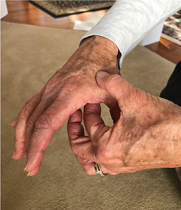
Hold the webbing between the thumb and forefinger of one hand between the thumb and pointer finger of the opposite hand, with the thumb on top and the finger below the webbing. While holding that point, think about what you want the animal to receive during his or her session. Slowly take three deep breaths. Then change hands and repeat the procedure.
Calming Acupressure-Massage Session for Dogs and Cats
Once you feel present and focused, you are ready to begin the session. Animals know immediately when you are thinking about something else, like what you need to buy at the store on your way home. The session will be much more effective if you are grounded, caring, and present.
Start by using the heel of your hand to slowly stroke down the animal’s body just to the side of his midline and spine from head to hind paw, following the Bladder Meridian Chart. Trace the meridian three times on each side of the animal’s body. This tells the bod or cat you are doing something other than petting him. Your intention is to be comforting and help him feel calm.
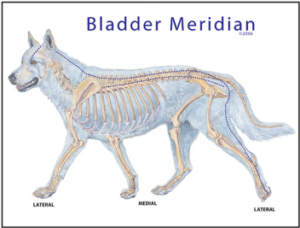
Once you have completed tracing the Bladder Meridian three times on each side of the animal’s body, you are ready to offer specific acupressure points to help restore a feeling of well-being (see charts below for the names and locations of these points). The acupressure points selected for animals in a shelter environment support general health, reduce fear, boost the spirit, and promote a sense of courage and well-being.
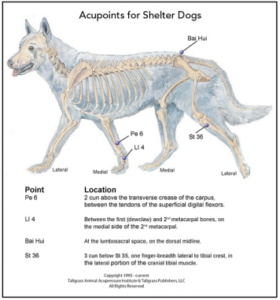
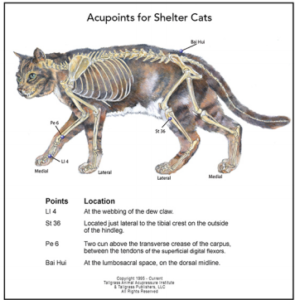
Acupressure Point Techniques
While performing acupressure point work. always have both hands on the animal at the same time. One hand is doing the point work while the other rests gently and comfortably somewhere on the dog or cat’s body. The resting hand can feel any reactions the animal has to the point work, while offering grounding and comfort.
If you are unfamiliar with acupressure, you need to know that there are two basic techniques for stimulating acupoints – the Thumb Technique and the Two-Finger Technique. Both are considered direct pressure techniques, called an An Fa in Chinese. There’s no need to press hard because the meridians and acupoints are just beneath the surface of the skin. In fact, gentler is better, so you won’t obstruct the flow of chi.
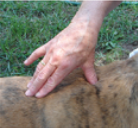 Thumb Technique – Gently place the soft tip of your thumb on the acupoint and count slowly to 20, then move to the next point. The
Thumb Technique – Gently place the soft tip of your thumb on the acupoint and count slowly to 20, then move to the next point. The
Thumb Technique works best on larger dogs and on a medium-sized dog’s trunk, neck, and larger muscle masses.- Two-Finger Technique – Place your middle finger on top of your index finger to
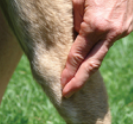 create a little tent. Then lightly put the soft tip of your index finger on the acupoint and count slowly to 20. This technique is good for point work on small dogs or cats, and for the lower extremities on medium-sized to large dogs.
create a little tent. Then lightly put the soft tip of your index finger on the acupoint and count slowly to 20. This technique is good for point work on small dogs or cats, and for the lower extremities on medium-sized to large dogs.
When you have completed the point work, trace the Bladder Meridian three times on each side of the animal just as you did at the beginning of the session. This gives the acupressure-massage session a finishing touch; it’s like smoothing a bedspread and tidying up the energy.
Soothing Ah-Shi points with Tui Na
Editor’s Note: This article has been sourced via Tallgrass Animal Acupressure Institute.
In Part One of this two-part series, we went over the nature of Ah-Shi points. We discussed how the muscle tissues tighten and become knotted. This can occur spontaneously due to physical or emotional stress, injury or disease. The result is the same: the tissues shut down, not allowing blood and chi to flow. The animal then experiences pain, which leads to restricted movement.
When Ah-Shi points and the surrounding tissue are not addressed quickly, the animal tends to compensate to avoid pain. This leads to the horse’s, dog’s, or cat’s entire body becoming physically compromised. What may have begun as a minor tightness can snowball into a major lameness. Acupressure-massage, called Tui-Na in Chinese, is a highly effective hands-on bodywork modality that is known to resolve Ah-Shi points and the surrounding tissues.
Tui Na
Tui Na is one of the five main branches of Traditional Chinese Medicine (TCM) along with diet, chi gong, herbs, and acupuncture. It is considered the original Chinese meridian massage. Tui Na is pronounced “Tway” with a long “a” sound and “Nah.” Translated, Tui Na means “push – grasp.” It has been continuously practiced in China for both humans and animals since 2700 B.C. Over time, these techniques followed the Silk Road to the Middle East and on up through Europe to Northern Europe.
Tui Na regulates meridians by promoting the circulation of chi, blood, and other vital substances. This, in turn, provides the energetic and nutrient nourishment necessary for the internal organs to function properly. When there’s a harmonious flow of vital substances, all the bodily tissues are nourished, and Ah-Shi points are less likely to form. However, if they do, they can be easily resolved with these hands-on techniques that have been used for centuries.
Tui Na Techniques
The first Tui Na technique is direct pressure, called An Fa. Begin pressing very lightly because the point can really hurt. Come away from the point and then press ever so slightly more into the point using the soft tip of your thumb, knuckle, or the heel of your hand. There are many variations of how to apply An Fa including crossed-hands or an elbow on larger equine muscle masses.
Tui Fa is a “pushing” technique that is used to trace a specific meridian that is blocked along its path and possibly where an Ah-Shi point has formed. The hand movement needs to be relaxed, smooth and consistently sliding along the meridian. Sliding up and back using the soft tip of the thumb, three fingers, or the heel of the hand removes obstructions and can invigorate the flow of chi and blood.
There are a huge number of Tui Na techniques to enhance the effectiveness of an acupressure-massage session that is best learned by taking hands-on training courses. The general purpose of using Tui Na techniques is to invigorate the harmonious flow of vital substances throughout the animal’s body to help resolve painful Ah-Shi points.
Feed Cranberries to Horses
Editor’s Note: This article has been sourced via Riva’s Remedies.
I’m always looking for new foods that horses might like to provide them with variety and extra nutrition. Turns out that raw organic cranberries are the new face around here – they gobble them right up even with the tart taste. Cranberries are rich in Manganese, Vitamin C, Vitamin E, fibre, and anti-oxidants. They are a natural anti-inflammatory and antibiotic, and are beneficial for the immune system and heart. Just add 1/4 cup to their breakfast.
To Blanket or Not to Blanket
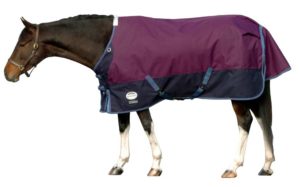
Reference: The original article was published by Carole Herder in Cavallo Horse & Rider.
To blanket or not to blanket – that is the question. That time of year is coming around again, the season is changing, the days are getting cooler and the nights are getting colder. All I see is horsey people running in and out to the paddocks and barns, taking blankets off, putting blankets on, holding different blankets up and trying to decide which weight to use. All of my friends are on their smart phones constantly checking out the weather to see if blankets are needed that night. Bordering on crazy!
The blanket question is almost as heated as the barefoot hoof question (but not quite!). Personally, I think there are pros and cons for each argument. Yes, we want to keep our horses more naturally and they have evolved to survive all kinds of weather, without human interference. And yes, there are many wild and feral horses across the globe who manage perfectly well without our rugs. But what if your horses aren’t kept naturally, what if you need them clipped or clean or dry, what if they are old and sick?
Horses are naturally equipped to deal with all kinds of weather. They have amazing inbuilt thermo-regulation devices! Thick winter hair will replace thin summer hair in order to help with insulation and act as a windbreaker. These layers will stand up when it is cold and lay down when it is warm. Raindrops and snowflakes literally fall off the downward tilted hairs. They have lightly muscled lower legs which consequently require less circulation and heat. Their large digestive tracts process a mostly fibrous diet when generates large amounts of heat. Long nasal passages warm the air before it reaches the lungs. Their relatively thick, blocky bodies retain heat for longer. They use their own rumps for wind blocks! Their blunt equine muzzles contain so much blood that the cold finds it hard to get in. If they choose to stand still rather than run around, they will shiver to keep warm – this is genuinely a highly effective heating device.
Consider the above pros and cons before donning your horse with a blanket this winter.
Does your horse love you?
Do your horses come when they are called?
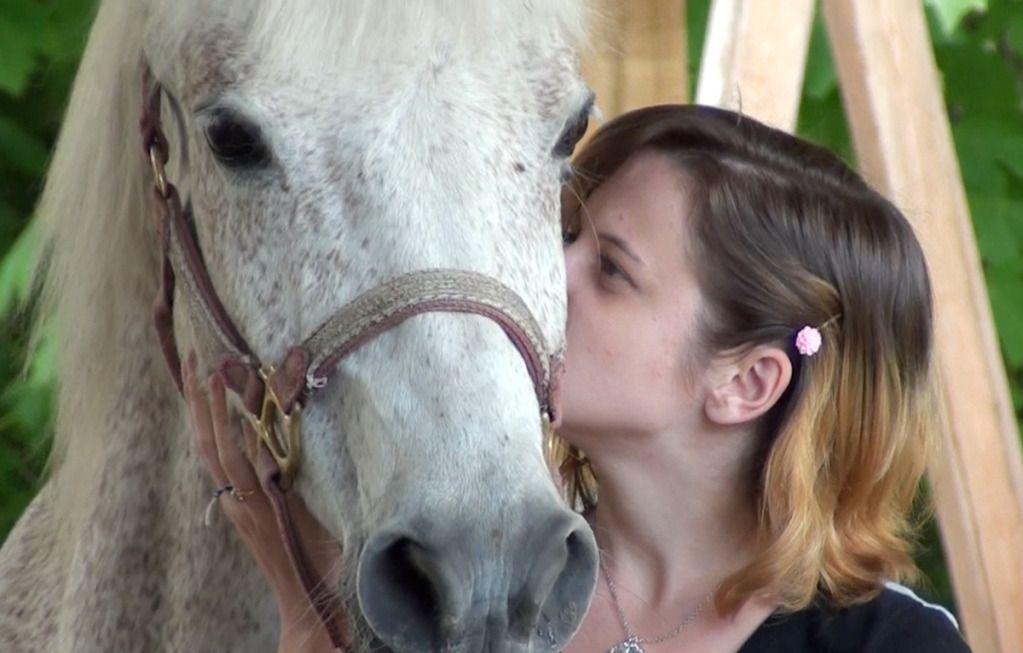 Do they show you where they’d like to be itched?
Do they show you where they’d like to be itched?
Do they follow you wanting more?
If you can’t answer yes to these questions then perhaps you need a relationship reviver! Here’s how you can get a yes to all the above:
1. Give your horse a reason to come when called – a healthy treat (black sunflower seeds are a great low sugar treat) or a bucket feed/hay, some nice grooming/itching and no riding or leaving friends for a while, can make a big difference.
2. Find your horse’s itchy spots – the ones that make their nose wiggle! Start on the neck, under the mane, around the withers and shoulders before venturing to sensitive areas such as under the belly, between the back legs etc. – take note of any sore or ‘don’t touch me there’ spots and perhaps get an equine body worker to investigate in case there’s a physical issue.
Professional Business Virtual Assistant Services
3. Choose from this list of Top Ten Fun Things to Do with your Horse. It is surprising how easily many riders and horse owners lose track of what’s so grand about horses in the midst of the pressure of competition, economic stresses, and time crunches. All too often we get caught up in the day-to-day “grind” of keeping horses —the ritual feeding, watering, and ….. We have to take a moment to remember that, more than anything else, being with horses is FUN. Most of us came to horses because we love them, and because riding and working with them brings us joy, peace, and fulfillment in ways that little else in life can. It is important to remind ourselves not to take horses and riding JUST seriously. Read the rest of this article from Trafalgar Square Book’s Blog here.
4. Or if you really want to focus on the relationship and take it to the next level, check out www.friendshiptraining.org – where people learn to be the friend their horse wants them to be and a whole lot more in the process.
Restricting Forage is Incredibly Stressful Pt.2
Here is Part 2 of Dr. Getty’s article on horse nutrition and health:
When a horse does lose weight through severe restriction, his metabolic rate slows down so dramatically that he can’t process a larger amount of food without gaining back all the lost weight and more when he returns to eating normally. The most likely next outcome is a laminitis attack.
Now, consider the free choice scenario: First, make sure what the horse is eating is low in NSC and low in calories. Once you know that it’s safe, then give your horse all he wants to eat 24/7, and never, ever let him run out—not even for 10 minutes. Very soon, your horse will eat only what he needs. Yes, at first he may overeat because he’s so excited, but once he realizes he can walk away and come back and figure out it’s no big deal—saying to himself the equivalent of “Yeah, yeah, it’s still there”—he will relax. Perceived starvation is no longer a threat and so his hormones start to calm down. His insulin level starts to drop. His body fat starts to be burned for energy rather than being held onto; his body also responds to the hormone, leptin, which tells him he is no longer hungry. He starts to lose weight, and lo and behold, he actually eats less than he did originally because when he has all that he wants, he knows how much he actually needs. Give him a chance to self regulate. A horse whose system is in healthy balance will not naturally overeat. Give him a chance to tell you what he needs.
Forget the dry lot with no hay. Forget the drastically reduced diet. I have seen this horrible damaging protocol again and again. I understand—it is difficult for horse owners to accept anything else. I am not arguing against restricting calories. Of course you have to do that, but you need to do it by giving a low calorie, low sugar/starch hay.
And you need to increase exercise. Exercise decreases insulin resistance. It also builds or helps protect muscle mass (which is metabolically more active) and certainly it directly burns calories which helps your horse lose weight.
Here’s an analogy: If I told you that you could lose weight by eating all the chocolate cake and ice cream you wanted and lolling around in a lounge chair all day, you would say that’s impossible—even ridiculous—and you’d be right. But if I said that you could lose weight if you chose to eat a lot of low calorie food—if you ate your fill of a variety of vegetables, for example—and got a reasonable amount of exercise, you would think that made sense. That’s what I’m telling you to do with your horse. Let him eat low calorie foods, all he wants, because that’s what he needs. Help him move around. You get the picture—I hope it makes sense now.
This article is an excerpt from the book, Equine Cushing’s Disease – Nutritional Management
For the growing community of horse owners and managers who allow their horses free choice feeding, there is a special forum for you to share your experiences with each other and to let me and others know how you’re doing. It is a place for support, celebrations, congratulations, and idea sharing. Go to jmgetty.blogspot.com.
Please share this article with your fellow horsemen and women. Permission to reprint commercially is granted, provided that full credit is given to Dr. Getty and publisher informs Dr. Getty about the use of the article. She may be reached at gettyequinenutrition@gmail.com. No editorial changes may be made without her approval.
Restricting Forage is Incredibly Stressful Pt.1
This is a very interesting article from Dr. Juliet Getty about how when we restrict food from our horses, their reactions manifest in different ways. This is Part 1 – stay tuned for Part 2!
Restricting Forage is Incredibly Stressful
Choose a different method to help your horse lose weight
By Juliet M. Getty, Ph.D.
Stress = Obesity. That’s right. Stress is keeping your horse fat. And the main source of stress for most horses? Restricting forage. The very thing most people do to try to help their horse lose weight actually causes the same stress reaction that brings about body fat retention, and all its attendant problems.
I cannot emphasize this enough. Here are the physiological facts—they are indisputable: The horse is a trickle feeder. He’s a grazing animal designed to chew all day long. His chewing produces saliva, which neutralizes the acid that’s continually flowing in his stomach. Your stomach produces acid only when you eat; your horse’s stomach produces acid constantly, even when the stomach is empty (you see where I am going with this—his stomach should never be empty!). He also needs forage flowing through his digestive tract to exercise those muscles; otherwise the muscles get flabby, which can bring on colic from a weak intestinal tract that torques and intussuscepts. Furthermore, the cecum (hindgut) contains the bacteria responsible for digesting fiber from forage. But its exit and entrance are both at the top! In order for digested material to be pushed to the top, the cecum must be full. Otherwise colic can result from material left at the bottom.
A horse that doesn’t have anything to eat will chew on whatever he can—fences, trees, even his own manure. It’s pitiful to see. Chewing on non-feedstuffs makes a horse mentally acutely uncomfortable because it goes against his instincts, but physically he is in pain and attempting to resolve it. Discomfort? Pain? Stress! And he’s stoic about it. You might look at him and say, “Well, he’s calm.” Sure, he may look that way but it’s an ingrained survival mechanism for horses that are in pain to hide it. In the wild, a horse that shows that he’s uncomfortable often gets left behind by the herd to fend for himself against predators. So anatomically and psychologically, the horse has evolved to deal with pain by simply bearing it. Even the pain of an empty stomach.
What happens when you bring this horse some hay? Against the fear of future deprivation and to relieve his stomach discomfort, he inhales it. Then he waits again for his next meal, even while the acid resumes bathing his empty stomach. And it’s not only the stomach that is affected. The acid can also damage the entire gastrointestinal tract, even making it all the way down to the hindgut. It can lead to colic and it can lead to laminitis.
I have seen hundreds of cases of horses suffering a laminitis relapse through being placed on a restrictive diet. Here’s the scenario: The horse is overweight (maybe even develops laminitis). The well-intentioned veterinarian tells the horse owner, “Put your horse in a dry lot and feed him only a little bit of hay, maybe about 1.5% of his body weight. Give several small hay meals a day, only.” And the rest of the time the horse stands there with an empty stomach. The well-intentioned veterinarian has just given the well-intentioned horse owner the worst possible advice because the stress of that leads to cortisol increase, which causes insulin to rise, and when insulin rises you have laminitis—new, recurrent or chronic. This happens over and over again; it is the unfortunate “conventional wisdom” of the horse industry.
I adamantly protest—this practice is not based on sound science.
For more from Dr. Getty – stay tuned for Part 2.
This article is an excerpt from the book, Equine Cushing’s Disease – Nutritional Management
For the growing community of horse owners and managers who allow their horses free choice feeding, there is a special forum for you to share your experiences with each other and to let me and others know how you’re doing. It is a place for support, celebrations, congratulations, and idea sharing. Go to jmgetty.blogspot.com.
Please share this article with your fellow horsemen and women. Permission to reprint commercially is granted, provided that full credit is given to Dr. Getty and publisher informs Dr. Getty about the use of the article. She may be reached at gettyequinenutrition@gmail.com. No editorial changes may be made without her approval.
Wood Temperament Horses
Sharing a mid-October update from the fantastic Madalyn Ward…
In her update she discusses the “Wood” temperament of horse and the different types and how the differences vastly change approaches in care and health. Enjoy!
Horse Temperament: The 2 Types of Wood Horse
When a person thinks about the Wood horse temperament what often comes to mind is a racehorse. The Wood horse temperament is powerful, athletic, smart and headstrong. These are great characteristics for a racehorse but not so good if you want a horse of your own to compete and have fun with. Yet, there are people out there competing and winning on Wood horses and having a blast with them. So what gives? The secret is they are buying a whole different type of Wood horse than the classic race horse Wood.
The Two Types
It has taken me a few years to understand that there are 2 types of Wood horse temperament, the classic racehorse and the less intense, show horse Wood. The racehorse Wood is typically a thoroughbred or appendix type quarter horse while your show horse is your ranch bred quarter horse or warmblood. Of course, any breed can be either type Wood but these are simply examples.
Wood Temperament Racehorse
The racehorse Wood temperament is all about power and speed. He is not intimidated or easily shifted off his opinions. The racehorse Wood wants to win at all costs. This Wood type has been bred for competing and winning for so long that it is in his makeup. It is as much an instinct to him as eating or drinking. Running is what he loves to do.
The racehorse type Wood can withstand the rigors of race training because he is happy doing that job, but put him in a show barn and he can develop many health challenges and vices. Ulcers, cribbing or stall weaving are just a few examples of what happens with a racehorse Wood that is not coping. To keep the racehorse Wood healthy and happy, you’d better have a training program that includes plenty of physical exercise. Pasture turnout and other Wood horse buddies can help as well. Be firm, but avoid confrontation. Instead work to redirect any excess exuberance into constructive exercises.
Wood Temperament Showhorse
If you take the racehorse Wood and dial him back about 50% you get the show horse Wood. Show horse breeders have recognized the challenge of dealing with a racehorse Wood, so they have crossed him with ranch type quarter horses or drafts to bring down the intense energy. The show horse Wood is still a great competitor, but he does not have the same intense desire to run. As a matter of fact, the show horse Wood can border on lazy if he is not enjoying his work. The show horse Wood can even balk or buck if he does not want to do something.
The show horse Wood does enjoy competing. He likes to win and thrives on a training program that focuses on improving his skills and strength. He does not seem to mind working when he sees a reason for it. The show horse Wood does not tolerate being drilled on exercises that are not directly related to his job. For example, if you want to work on transitions of lead changes, do this between small jumps or barrels set up in a pattern. Get out of the ring anytime you can and work in open fields or on the trail. Take your English Wood show horse to work cows or your cow horse to jump jumps.
The show type Wood horse temperament does not have as many health and stall vices when stressed, but they sure will get unruly. Expect to find buckets and tubs destroyed when the show type Wood horse gets bored. Pawing and kicking are signs of a show Wood horse with too much feed and not enough work. If your show horse type Wood has to live in a stall make sure he is tired when he is in it. He may not be going out for regular gallops like the race horse Wood but you can sure take him to the round pen or for a long ride on off training days.
So if you are looking to buy a Wood horse temperament of any breed, think carefully about what you are wanting and able to handle. So many times a person is thrilled by watching a racehorse type Wood perform but has the job and skill level for a show horse type Wood. This is why one person can have a Wood show horse that they love and win consistently with while another has a Wood horse temperament that borders on dangerous if not handled expertly. It is not the Wood horse that is the problem, but rather the type of Wood horse that is not a match for the expectations of the person.
Whichever kind of Wood Temperament you have, what you feed and how you handle them can affect their health and behavior.
Please also enjoy all of Dr. Ward’s web resources:
http://www.holistichorsekeeping.com
http://www.facebook.com/HorseHarmony
Twitter: madalynward



